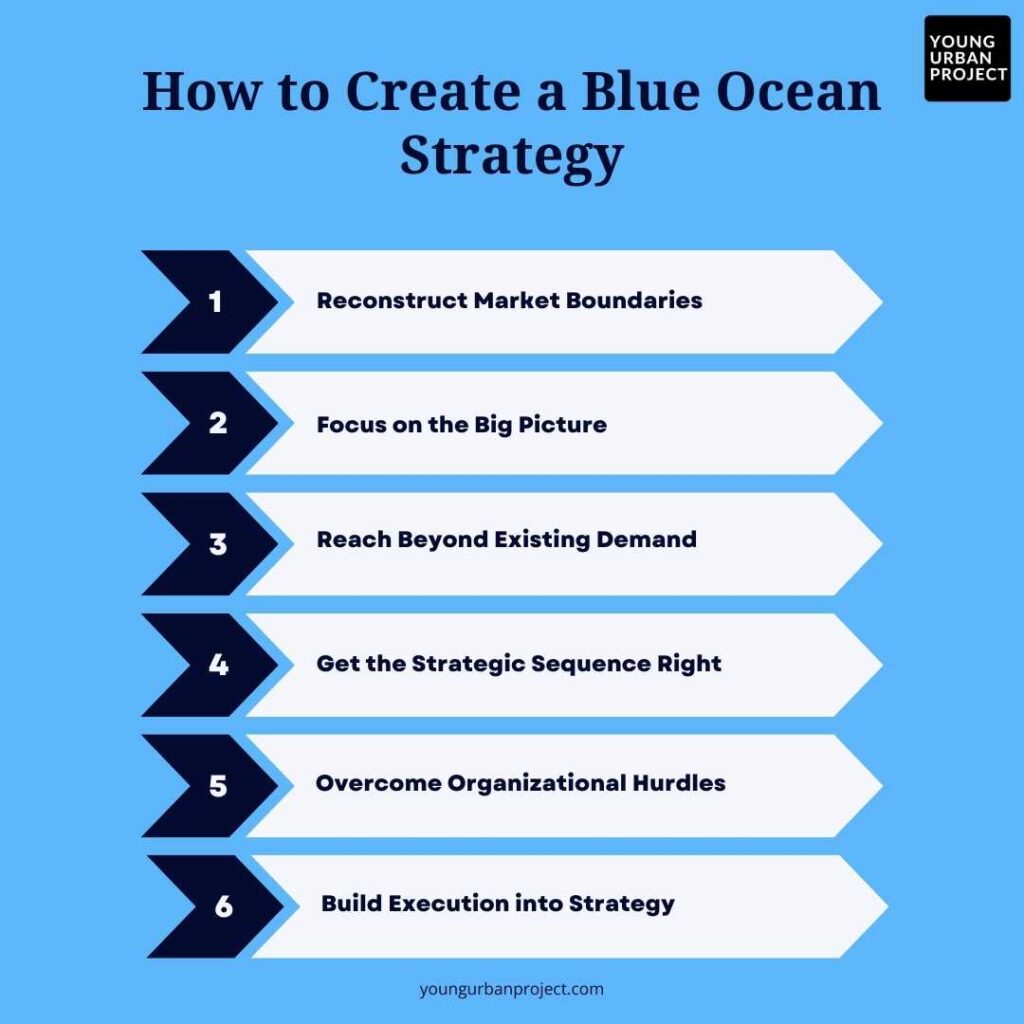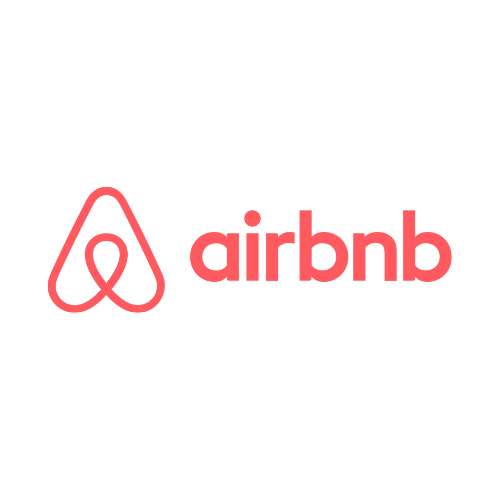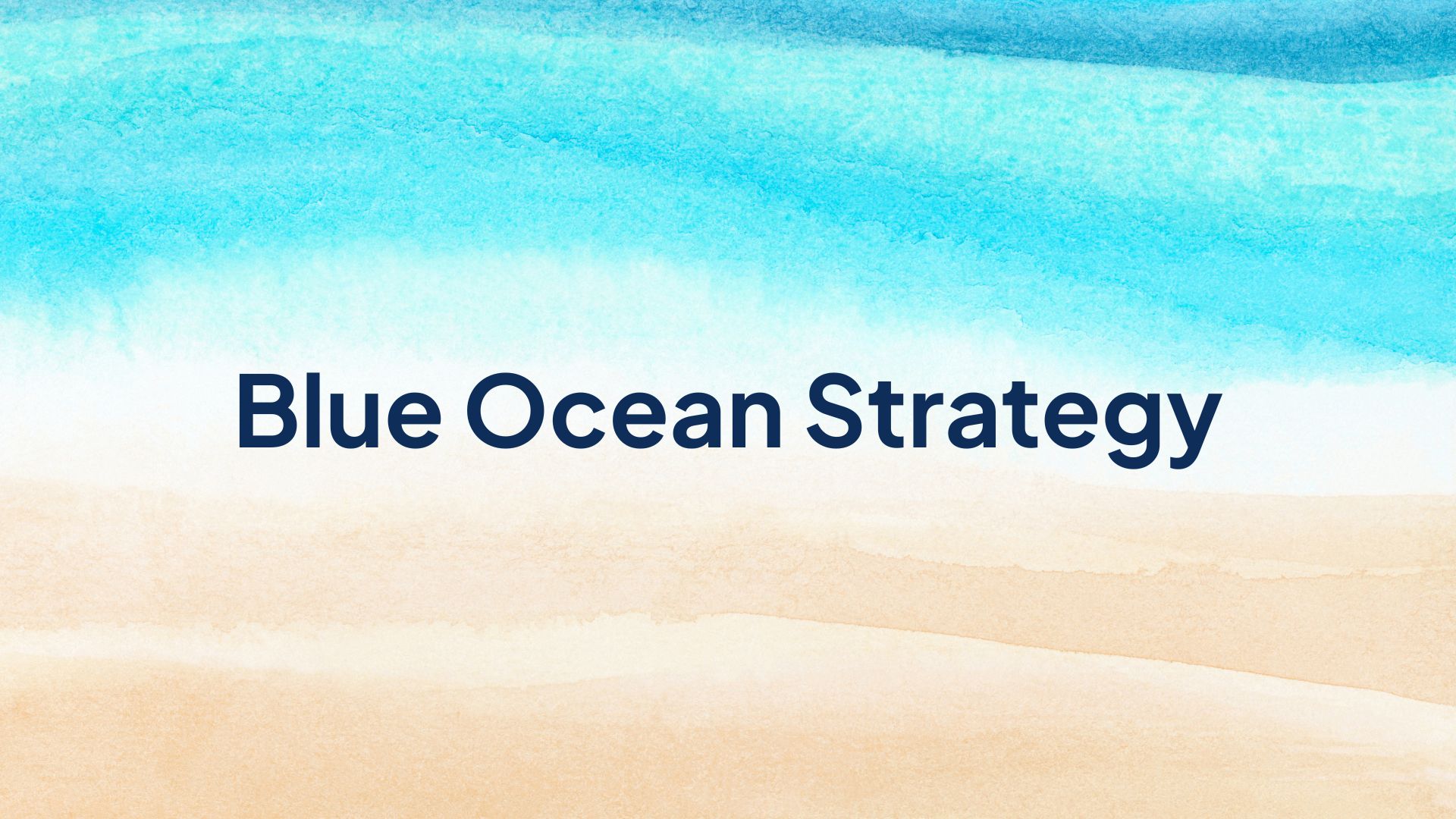Ever felt like your business is drowning in a sea of competitors? Traditional markets today are increasingly crowded, with companies fighting for the same customers and slashing prices just to stay afloat. But what if there’s a way out? Enter Blue Ocean Strategy – a revolutionary approach that contrasts crowded “red oceans” of competition with wide-open “blue oceans” of new market space. Developed by INSEAD professors W. Chan Kim and Renée Mauborgne and published in the Harvard Business Review, this concept shows businesses how to create their own blue oceans where competition becomes irrelevant. In this blog, you’ll learn what Blue Ocean Strategy is, how it works, and practical steps to implement it.
Table of Contents
What is the Blue Ocean Strategy?
Blue Ocean Strategy is a business approach that focuses on creating new, untapped market spaces rather than competing in existing ones. It’s about making your competitors irrelevant by offering something so different that you essentially create your own playing field.
The concept was introduced by W. Chan Kim and Renée Mauborgne in their 2005 book “Blue Ocean Strategy: How to Create Uncontested Market Space and Make the Competition Irrelevant.” After studying 150+ strategic moves across 30+ industries, they found that the most successful companies didn’t just compete better—they avoided competition altogether.
Blue Ocean Strategy is about:
- Finding uncontested market space
- Creating your own space instead of fighting for a spot.
- Breaking the value-cost trade-off (offering more value at lower cost)
- Making competition irrelevant through innovation
Instead of trying to win in crowded markets where everyone offers similar things, Blue Ocean Strategy helps you find or create entirely new markets where you can thrive.
What are Red Oceans?🔴
Red oceans are all the markets that exist today. These are industries where many companies fight for the same customers. The competition is tough, and businesses try to win by lowering prices or offering more features. It’s called “red” because of the bloody battle between rivals.
Key Characteristics:
- Heavy competition
- Fighting for the same customers
- Very little room for growth
- Price wars are common
- Hard to stand out
What are Blue Oceans?🔵
Blue oceans are new market spaces where no one else is competing yet. In a blue ocean, you create something different that brings in new customers. There’s no fight because you are the first or only one doing it. This allows you to grow without pressure from rivals.
Key Characteristics:
- No competition (or very little)
- Creates new demand
- Focus on innovation
- High chance of growth
- Makes the competition irrelevant
Also Read: How to Build A Social Media Marketing Strategy in 7 Steps
Key Differences: Red Ocean Strategy vs. Blue Ocean Strategy

| Feature | Red Ocean Strategy | Blue Ocean Strategy |
| Market Type | Existing markets | New or unknown markets |
| Competition | Fight with many rivals | No direct competition |
| Focus | Beat the competition | Make the competition irrelevant |
| Demand | Limited and shared | Created from new ideas |
| Strategy Goal | Gain a bigger share of the current market | Create and capture new market space |
| Innovation Level | Low – improve existing offers | High – create something different |
| Growth Potential | Slower and limited | Fast and scalable |
| Example | Traditional airlines | Cirque du Soleil, iTunes, Airbnb |
How to Create a Blue Ocean Strategy

1. Reconstruct Market Boundaries
Think beyond the usual market rules. Ask questions like: Who else can use this product? What else can we solve? By exploring different angles, you can discover new spaces with little or no competition. It’s about finding fresh ways to serve people, not just copying others.
2. Focus on the Big Picture
Instead of only looking at numbers or small tasks, think about the overall goal. What kind of value can you give that no one else does? Focus on long-term success, not just daily wins. A clear vision helps you find a path others haven’t noticed.
3. Reach Beyond Existing Demand
Don’t just focus on your current customers. Look for people who aren’t using your product yet but might if it solved their problem. Think about why some people avoid your industry. If you can reach them, you create new demand instead of fighting for the old one.
4. Get the Strategic Sequence Right
There’s a right order to follow. First, create a great idea. Then make sure it gives value to customers. After that, check if it can make money. Finally, make sure your team can actually do it. Skipping steps can lead to failure, even if the idea is good.
5. Overcome Organizational Hurdles
Even the best idea won’t work if your team doesn’t support it. You need to prepare your people and fix any internal problems. Get everyone involved and excited about the new direction. It’s important to remove fears and build trust within the company.
6. Build Execution into Strategy
Don’t treat planning and doing as two separate things. Your strategy should be simple enough to follow and strong enough to act on. Everyone in your team should understand it and know their role. When people take action together, the new strategy has a real chance to succeed.
Also Read: Go-To-Market (GTM) Strategy Framework
Tools & Frameworks in Blue Ocean Strategy
1. Strategy Canvas
The strategy canvas is a simple chart that helps you compare your business with others. You can see what your industry offers and where you can do something different. It shows where the competition is strong and where you can stand out by offering more value or something totally new.
2. Four Actions Framework (Eliminate-Reduce-Raise-Create Grid)
This tool helps you think clearly about what to change in your product or service. Ask: What can we eliminate? What can we reduce? What can we raise? What can we create? It helps remove waste and add value that truly matters to your customers.
3. Buyer Utility Map
The Buyer Utility Map shows how your product helps customers in different ways. It also helps spot where your product is not useful or missing something. You look at the full customer experience, from start to finish, and find chances to improve or create something new.
4. PMS Map (Pioneers–Migrators–Settlers)
This map helps you look at your product ideas in three groups. Pioneers are new and exciting ideas. Migrators are better versions of what already exists. Settlers are common and offer little new value. A strong strategy needs more Pioneers to help you lead the market.
5. Six Paths Framework
This framework shows six ways to look at your market differently. It helps you break the rules and find new spaces. You can look across industries, buyer groups, product uses, and more. It opens your mind to new ideas and shows how to escape the crowded market space.
Also Read: What is Go-To-Market Strategy
Real-World Examples of Blue Ocean Strategy
1. Cirque du Soleil

Cirque du Soleil completely reimagined the circus industry when it launched in 1984. Traditional circuses were struggling with declining audiences, animal rights concerns, and high costs for star performers. Instead of competing directly, Cirque created an entirely new category by:
- Eliminating animals and star performers (major cost reductions)
- Adding theatrical storylines, original music, and artistic themes
- Creating sophisticated environments with custom venues
- Targeting adults willing to pay premium prices rather than children
The result? While Ringling Bros. and other traditional circuses eventually went bankrupt, Cirque du Soleil grew into a billion-dollar entertainment giant by appealing to theater-goers who would never attend a traditional circus.
2. Apple iTunes

When Apple launched iTunes in 2003, the music industry was in chaos. Illegal file-sharing through platforms like Napster was rampant, and traditional CD sales were plummeting. Instead of trying to sell physical media or fight piracy directly, Apple:
- Created a legal, easy-to-use digital marketplace
- Offered songs individually for just 99 cents (breaking up the album format)
- Made the system seamless with their iPod devices
- Provided a better user experience than illegal alternatives
By solving problems for both consumers (affordable, convenient access) and the music industry (legal revenue model), Apple created a blue ocean that generated billions in revenue while transforming how people consume music.
3. Yellow Tail Wine

The wine industry was traditionally complex, intimidating, and focused on sophisticated consumers. When Australian brand Yellow Tail entered the U.S. market in 2000, they threw out the rulebook by:
- Simplifying their offering to just two wines initially (a red and a white)
- Creating an approachable, fun brand with the distinctive kangaroo logo
- Removing wine jargon and terminology from packaging
- Making the wine sweeter and more approachable for beginners
- Pricing it affordably ($6-7 range) but above budget wines
While traditional wineries focused on complexity and prestige, Yellow Tail grew explosively by targeting the massive market of casual drinkers who found traditional wine culture intimidating. Within just two years, they became the #1 imported wine to the U.S.
4. Tesla

When Tesla launched its first car, the electric vehicle market was tiny and focused on economy cars with limited range and poor performance. Instead of competing with Toyota’s Prius or Nissan’s Leaf, Tesla:
- Started with a premium sports car (the Roadster)
- Focused on performance and luxury, not just eco-friendliness
- Built a proprietary charging network to solve range anxiety
- Created a direct-to-consumer sales model
- Designed cars with software at their core, enabling updates
Tesla created a blue ocean by targeting luxury car buyers who wanted both performance and environmental credentials—two attributes that traditionally didn’t go together. This allowed them to command premium prices while establishing the brand before moving downstream to more affordable models.
5. Airbnb

The traditional hospitality industry focused on standardization and professional service, with hotels competing on location, amenities, and loyalty programs. Airbnb created an entirely new market by:
- Turning ordinary homes into potential accommodations
- Enabling authentic, local experiences rather than standardized hotel stays
- Building a service where travelers can book stays straight from hosts.
- Offering unique spaces (from treehouses to castles) unavailable in traditional hotels
- Providing options in residential neighborhoods away from hotel districts
By unlocking a massive supply of rooms that previously didn’t exist in the market, Airbnb created affordable options in expensive cities while offering truly unique experiences that hotels couldn’t match.
Also Read: Product Marketing Strategies and Examples
Lesser-Known Blue Ocean Examples
1. Betterment (Robo-Advisor)

While traditional financial advisors required high minimum investments ($250,000+) and charged 1-2% annual fees, Betterment created a blue ocean by:
- Eliminating minimum investment requirements
- Charging just 0.25% annual fees or $4 per month
- Providing automated portfolio management accessible to beginners
- Offering tax-loss harvesting previously available only to wealthy clients
This opened investment advisory services to millions of young and middle-income consumers ignored by traditional financial advisors.
2. Rent the Runway

The fashion industry traditionally forced consumers to choose between buying expensive designer clothing or settling for affordable fast fashion. Rent the Runway created a blue ocean by:
- Offering rental access to designer clothes for special occasions
- Creating subscription models for everyday designer wear
- Handling cleaning and logistics that make sharing clothing practical
- Building technology to manage inventory and fit recommendations
This new market allowed fashion-conscious consumers to access luxury brands at a fraction of purchase prices while creating an entirely new revenue model for designers.
3. Beyond Meat

Rather than competing directly with traditional meat companies or targeting only committed vegetarians, Beyond Meat created a blue ocean by:
- Developing plant-based products that closely mimicked the taste and texture of meat
- Positioning products in the meat section of grocery stores (not vegetarian aisles)
- Targeting “flexitarians” who eat less meat but don’t give it up completely.
- Focusing on environmental and health benefits appealing to mainstream consumers
This approach created explosive growth by appealing to a much larger market than traditional vegetarian products, which had always been niche offerings.
Also Read: AI in Marketing Strategy
Challenges in Implementing the Blue Ocean Strategy
1. Organizational Resistance
People naturally fight change. When you try to create a blue ocean, existing teams may push back because they’re comfortable with old ways. Sales teams might worry about learning new markets, while product teams may resist changing successful formulas. To overcome this, use the “Three E Principles” from Blue Ocean Strategy: engage key players early, explain why change is needed, and set clear expectations about what will change and what won’t.
2. Execution Barriers
Many companies develop brilliant blue ocean ideas but fail when putting them into practice. Common execution problems include unclear leadership, missing deadlines, and poor coordination between departments. The “Tipping Point Leadership” framework helps overcome these barriers by focusing limited resources on key influencers, making the need for change crystal clear, and creating quick wins to build momentum rather than trying to change everything at once.
3. Misinterpreting the Framework as “Blue Sky Thinking”
A dangerous mistake is viewing Blue Ocean Strategy as just “thinking outside the box” without structure. This leads to impractical ideas that don’t connect to real market needs. The Strategy Canvas and Four Actions Framework prevent this by keeping innovation grounded in customer value. These tools force you to make concrete trade-offs about what to eliminate, reduce, raise, and create—turning vague concepts into actionable business models that actually work.
4. Resource Limitations
Most organizations face tight budgets and limited people when trying something new. Since creating blue oceans often requires investment before returns come in, resource constraints can kill innovation. The “Strategic Sequence” framework helps by validating ideas before major investment: testing buyer utility first, then price, then cost, and finally adoption barriers. This step-by-step approach reduces wasted resources and increases success rates by catching flawed concepts early.
When Should You Choose Blue Ocean Strategy?
1. For Startups Entering Saturated Markets
When entering crowded markets as a startup, competing head-on against established players is usually suicide. Blue Ocean Strategy offers a smarter path by helping you find unserved segments or needs. By using the Six Paths Framework, startups can discover opportunities hidden in plain sight—like how Square didn’t just make another payment processor but created a simple system for small vendors who were ignored by traditional processors. This approach lets startups grow without directly fighting industry giants.
2. For Established Businesses Facing Declining Growth
When your company hits growth limits in current markets, Blue Ocean Strategy becomes essential. Warning signs include shrinking profit margins, price wars with competitors, and products becoming commodities. The Strategy Canvas helps identify areas where your industry over-serves or under-serves customers. Companies like Nintendo used this approach when they created the Wii—stopping the technology arms race with Sony and Microsoft to instead focus on casual gamers overlooked by the industry.
3. During Strategic Pivot or Innovation Roadmap Planning
Blue Ocean Strategy works best during major planning cycles when you’re already rethinking direction. Whether developing a three-year innovation roadmap or responding to market disruption, these frameworks provide structure to your pivot. The Eliminate-Reduce-Raise-Create Grid forces leadership teams to make concrete choices about what to change, preventing vague “innovation initiatives” that go nowhere. This timing allows blue ocean thinking to influence budgets, talent allocation, and goals while they’re still being set.
Enroll Now: Live Performance Marketing Course
Conclusion
Moving from red to blue oceans isn’t easy, but it’s increasingly necessary for long-term success. The key insight of the Blue Ocean Strategy is that market boundaries exist only in our minds – they can be reconstructed by looking across traditional limitations. By focusing on non-customers and their needs rather than existing competitors, businesses can discover entirely new possibilities for growth.
As W. Chan Kim and Renée Mauborgne put it: “The only way to beat the competition is to stop trying to beat the competition.” This means shifting your focus from outperforming rivals to making them irrelevant by creating a leap in value for buyers and your company. The tools and frameworks of Blue Ocean Strategy provide a practical roadmap for this journey, helping you swim away from the bloody competition and into clear blue waters of new market space.
FAQs: Blue Ocean Strategy
1. What is the Blue Ocean Strategy in simple words?
Blue Ocean Strategy is a business approach where you stop fighting with competitors over the same customers and instead create a new market space where you can grow freely. It’s like finding an empty blue ocean to swim in rather than a crowded red ocean where everyone is fighting for the same fish. The goal is to make your competition irrelevant by offering something truly different.
2. How does the Blue Ocean Strategy work?
Blue Ocean Strategy works through value innovation – giving buyers more value while cutting your costs. First, you map what your industry currently competes on using the Strategy Canvas. Then you apply the Four Actions Framework: eliminate factors the industry takes for granted, reduce others below industry standards, raise some well above standards, and create elements never offered before. This creates a new value curve that attracts non-customers.
3. What are some good brand examples of Blue Ocean Strategy?
Cirque du Soleil created a blue ocean by eliminating animals and star performers while adding theatrical elements, transforming the circus experience. Apple’s iTunes offered legal, affordable music downloads during the piracy era. Yellow Tail simplified wine for casual drinkers. Tesla made electric cars desirable by focusing on performance and luxury. Airbnb turned ordinary homes into unique accommodation options outside traditional hotel districts.
4. How do you know if your business needs Blue Ocean Strategy?
Your business likely needs Blue Ocean Strategy if you’re facing intense price competition, your products are becoming commodities, profit margins are shrinking, or growth is stalling. Other signs include customers seeing little difference between your offerings and competitors’, or when industry players are all following the same strategies. If your market feels oversaturated and you’re fighting for every customer, it’s time to find a blue ocean.

